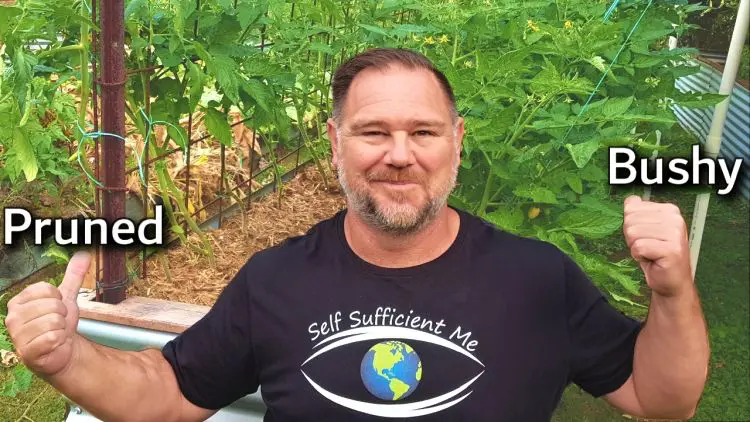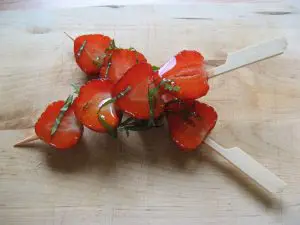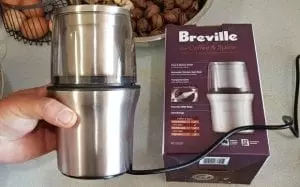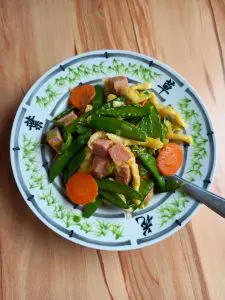To prune, or not to prune….that is the question! I’m talking about tomato plants, of course, and in this article I’m going to explain why sometimes you should prune tomatoes, and sometimes you shouldn’t.

Types of Tomato Plant
There are several things I look for whenever I’m thinking of pruning tomato plants, and the first & most important is the type of tomato plant. Basically there are 2 types of tomato plants: determinate and indeterminate. Determinate or bush varieties reach a limited height (usually 90cm or 3′) and are less common. Indeterminate types just keep growing and sprawling, hence the name. They can reach a height of 2-10m (6-20′) if left untrained.
Indeterminate tomatoes generally need to be pruned quite a lot. Not only does this make them easier to manage, but continual pruning gives you a better yield. I start by stripping the bottom 2′ of foliage from the plants, which allows for good airflow. This is really important for tomatoes because they are susceptible to soil-borne fungal diseases.

As a general rule, I don’t prune determinate tomato plants much at all. As they have a limited height, I find that too much pruning stunts their growth. With determinate-type tomatoes, I have found that reducing the amount of leaders (side branches) significantly reduces the amount of fruit. You will still need to stake and support these bush varieties, but generally you’ll only need to prune back some of the lower foliage.
Intercropping
Intercropping is the practice of growing two or more crops close together, usually in the space between rows. If I want to intercrop something else with my tomatoes, then I’ll definitely prune the lower tomato foliage so that the secondary crop can get enough light.

I love that intercropping maximises return on the garden bed space, and find that low-growing choices like lettuce, beetroot, dwarf beans or peas do best. Peas and beans have the added bonus of being nitrogen-fixers, so they can help tomatoes grow better.
Disease
Disease is a major factor to consider when deciding whether to prune tomatoes or not. The lower branches of tomato plants inevitably become diseased first. This is because they have the most exposure to the soil, which is where fungus hides. As a general rule, I will trim at least several branches off both determinate and indeterminate tomatoes, so that the lowest several inches of the stems are bare.
Trimming around the base of the plants limits the spread of disease and maximises air flow through the foliage, both of which are important for plant health. Pruning off any damaged or bug-ridden tomatoes will help too: there’s no point letting the bad critters multiply.

None of this will stop tomatoes from getting overpowered by disease at the end of the season, but it will maintain plant health and fruit quality for as long as possible.
Growing Side by Side
When I grow a row of tomato plants side by side along a garden bed I prune them quite savagely. This is because I put them closer together than the standard 40cm spacing. I like to squash my plants in a bit, but extra pruning is the compromise I have to make for this. My subtropical (south-east Queensland) climate can be very humid, so maximising air flow via harsh pruning is key to keeping the plants healthy. Despite this, you need to be careful not to over-prune. Too much defoliation of a growing plant can stunt growth. At the very least, always leave the top few branches intact.

It would be fair to ask why I don’t have less plants and space them out more. This is because indeterminate varieties with large fruit give better results if you prune them back to one main stem and a maximum of 3 leaders (leaders are smaller offshoot stems). Trimming them in this way gives the best yield and optimises plant strength. This is thought to make the tomatoes grow a bit bigger than when the plant is allowed to bush out & grow a lot of trusses. Letting tomato plants sprawl and develop several main stems over a larger area works best for determinate or bush-type tomatoes.
The Exceptions
There are some exceptions to all the above, and one of those is the rootstock tomato. This is like an ancient tomato variety which bears tiny currant-sized fruit. This particular tomato grows vigorously, and will do so in difficult soils & positions. They are a tough tomato plant that I like to grow as an insurance against crop failure…and of course to eat!

Rootstock tomatoes don’t like getting pruned too much, as it will limit their growth and fruit bearing. This big, bushy, vigorous type of tomato likes to protect its fruit by setting it in the inner foliage. As the fruit are so small they can quickly burn & shrivel, I like to keep plenty of foliage around them. If you do see a bit of disease you can remove the affected branches. Personally I usually leave these plants alone as they love growing bushy.
If you have a lot of space you might like to experiment with letting an indeterminate tomato grow bushy. They are designed to sprawl, so if you have room you can moderate your pruning and let it grow semi-wild. Remember to trellis or stake it, as fruit left on the ground can spoil easily.
For a video of this article, visit our youtube channel by clicking the link below!













